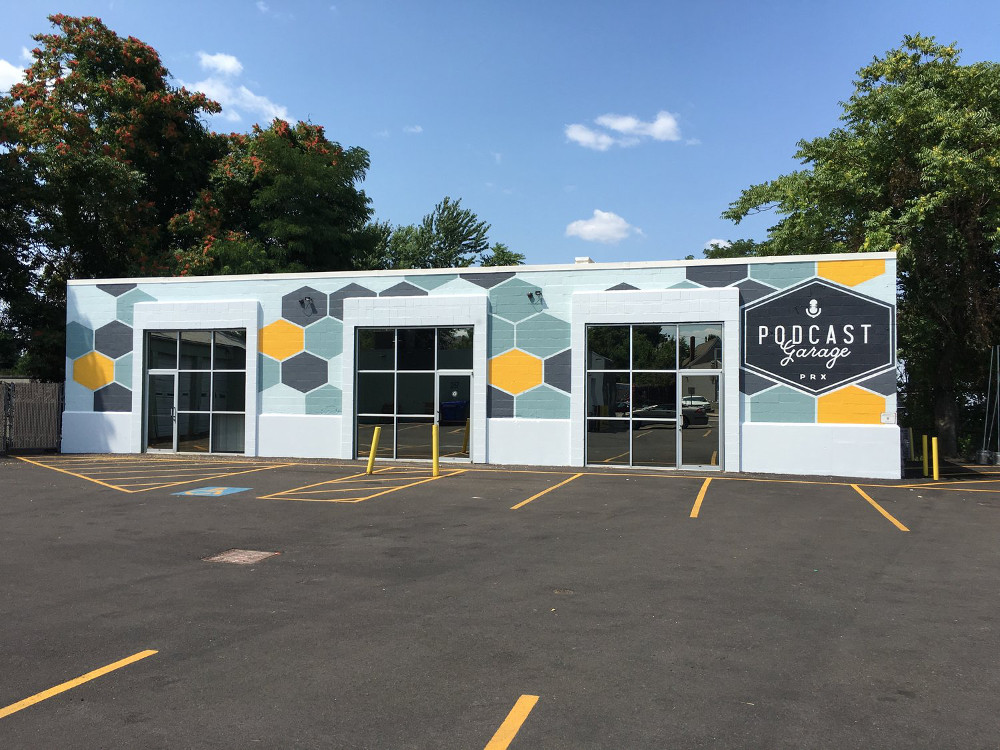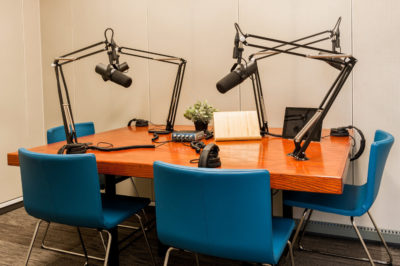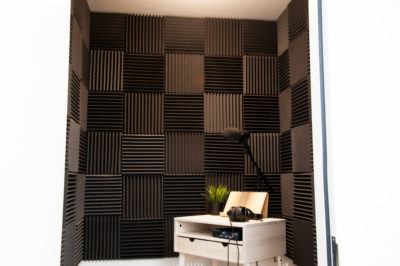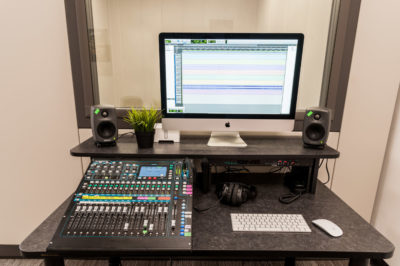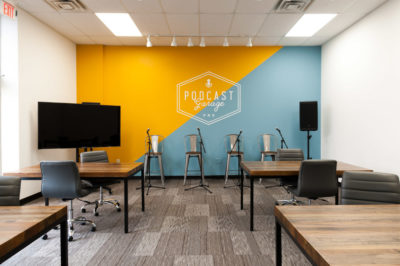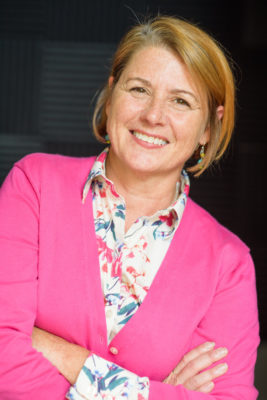The Podcast Garage: A New Facility Converges Community, Audio and Storytelling
What’s your story?
For anyone who can access a microphone and the Internet, there’s never been a better time to be a storyteller. That’s because the ancient practice of passing along information orally has evolved once again with the popularity of podcasts.
According to the latest statistics, podcasts – digital audio files from a themed series that can be downloaded into a computer or portable device – are strongly on the rise. Through 2016, 21% of Americans aged 12 and up have listened to a podcast in the past month, up from 17% in 2015, all part of a 75% increase since 2013. Driven by the immense popularity of series like Sarah Koenig’s “Serial,” that’s an overall audience of 51 million Americans, a listenership roughly equivalent to Twitter’s active user base.
While the Boston-based public media company Public Radio Exchange a.k.a. PRX can’t take all the credit for these positive trends, they certainly have had a hand in it. The company has operated public radio’s largest distribution marketplace for over a decade, with thousands of shows available on their Website including This American Life, The Moth Radio Hour, and Reveal. A visit to PRX.org unlocks a treasure trove of podcast discovery, with scores of fascinating titles just a click or touch away. PRX is also the creator of Radiotopia, a podcast collective of 15 story-driven shows which spawns over 12 million downloads per month.
Now PRX has elevated their commitment to podcasts even further, enabling not just distribution but also creation with their newly opened Podcast Garage in Boston. An uncommonly welcoming environment, it hosts low-cost recording studios, free co-working space, and educational and networking events, all serving as an affordable resource and community hub for the area’s audio storytellers. Equipment from the likes of Shure and Sennheiser are onsite, with audio editors including Pro Tools and the broadcast/podcast-oriented Hindenburg.
The Garage is off to a strong start, as evidenced by their guestbook. Armed with a big roster of partners, the facility has an ambitious agenda to help Boston’s independent podcaster community learn new skills, get feedback on their work in a safe space, and use pro-level technology to create their own audio content.
PRX may be going way out of its way to groom the next level of podcasters, but there are some very good reasons for that. A conversation with Kerri Hoffman, CEO of PRX, goes deeper into their methods and motivations for creating a successful community center based around audio.
Kerri, what does the podcast represent in the current culture? Is it a medium? An artform? Why is it an expression worthy of such intensive nurturing?
We’ve been working in public radio and podcasting since we started in 2003. In the early days of PRX, the intent behind forming our organization was to solve a problem: The problem was that really great audio stories were being produced, aired once, and then lost forever. In public radio, no one had created an evergreen database where you could access and license that content.
So we gave a longer shelf life to content, and we also gave the creators an additional revenue stream to monetize that content. The third piece of that puzzle was by having an accessible database, we normalized listening to NPR content that was not on the radio – we were really early in that movement, and over the years we’ve been able to diversify the public radio airwaves by building a vast catalog.
Remember that at that time, around 2003, public radio was airing nationally syndicated programming or local programming, with nothing in between. By having a bigger catalog, they had more variety and could make more choices available that were relevant to their local audience.
Early on PRX made essential decisions about our own technology. We built our own tools so we could reduce chokepoints in the distribution path, and over time we built the first mobile app for public radio, and streamed on XM. And we’ve been working with producers all along — long before “Serial” was launched in 2014, we were working with producers that were accessible but not visible.
One of podcasters’ primary pain points at the time was, “How do I grow my audience without that broadcast lift? How do I monetize and introduce people to my content?” So we set out to solve those problems and created Radiotopia, where PRX took care of all the money-raising and ad serving, and grew that from a collection of seven shows to what is now 14.
By doing that we thought, “OK, now we know a lot about these indie producers. We know how to get onto stations and reach an audience, but many of them are working in makeshift studios in their closets. They’re isolated from each other, working in coffee shops and libraries, and they frequently don’t have good Internet.”
How did that go on to shape the concept for the Podcast Garage?
The Garage allowed us to build on all the things we been learning over a dozen years: How do we take a new generation of content producers, give them a studio to create in, and a curriculum for them to hone their skills? And how do we do that in a way that’s not derivative of broadcast?
A big reason that we’re doing this now is because we believe that podcasting is not a bubble. Access has improved, and podcasting is perfect for the smart phone environment: You can download the files and consume them off-broadband. And the content is amazing! The reducing of the technical barriers has made it even more compelling. It’s almost like old-time radio is back, but in an on-demand way.
We think about this a lot, because we really believe in the mission of public radio – but what does it look like in an online environment? Public radio is strong, and it will be for some time. We need to take the interest of on-demand and the simplicity of radio, and mash those two things together.
A lot of people in our industry are wringing their hands because they think podcasting is cannibalizing radio, but I don’t see it that way. We’re growing an audience for audio that people will hear it while they’re jogging, in their car, etc… We just need to keep making great content that people are consuming, and we need to find a new way to connect with those fans.
A Place for Podcasting
How did the Podcast Garage get constructed – was it built new from the ground up?
Picture an old Jiffy Lube, which is what this place used to be. It has two main rooms inside, one is a community space where we do events, and the other is the studio where the recording can happen. We originally were going to have four small one-person vocal booths, but instead we opted for a larger four-person booth.
Since were not paying an engineer, we have almost no overhead. That can attract a one-person show, or seasoned producers with a larger show. So we created a larger studio, and also a vocal tracking booth as well as a smaller room that can fit two people, for spillover. Those rooms are Wenger SoundLok sound isolation rooms, which is a kit that you buy. A lot of universities use them for rehearsal space for musicians.
Another key choice that we made is that the studio is really built for a digital environment, with the four most popular audio editing software suites. Traditionally, if you go to a public radio station to record some tracks – as many podcast producers do – they give you the WAV file and then you leave to edit it. At the Garage, we’re giving you the software in the studio so you can do a full session: editing it, adding additional audio, re-recording tracks. We designed it for an interactive production process, because that’s how people work. But even the most inexperienced person can come in, record something, and leave with a thumb drive.
And it’s right there on street level, for community access. Often studios are in basements with interior walls because of soundproofing, but we want these studios to have lots of natural light, as well as good microphones. But like I said, it’s not just a build of studios – the community room is very important, because that’s where we connect. We’re looking for talented producers who we don’t already know, so you have to have an open environment to appeal to that serendipity.
How long did it take to go from idea to reality? What were some of the surprises along the way as the Podcast Garage was constructed?
It came together pretty quickly, in about 10 weeks. The Garage is in a part of Boston with lots of pop-up events happening, so Wednesday nights in the parking lot Aeronaut brewing company has craft beers. We open up our doors, they open up theirs – it’s been really fun to be part of the community revitalization.
Achieving Superior Sound
How important is “good sound” to podcasting? What kind of audio fidelity standards are adhered to or were set for the Podcast Garage?
We work with some of the most talented producers in the world. We put a high value on production quality for all of our Radiotopia shows.
We also want the podcast studio to be open to people who are learning, and we put a high value on training and teaching the skills. We think training is important, because the threshold for starting a podcast is so low now: There’s lots of two-people-and-a-microphone podcasts, which is fine but that’s not who we’re partnering with. We’re on the high end.
But PRX has an open platform, and the Garage is now open to the general public. No one is going to walk in the door, say, “I want to do a podcast,” and have all the years and years of experience that our producers have. But we do want to be available to people from other creative paths, like filmmakers, who have adjacent skill sets.
Are there people that help them out?
We have no engineer onsite, but we have a list of engineers that you can call if you need help with a more complicated project. Most podcasts don’t need an engineer, but we have a community manager onsite, as well as one of our technical staff who install the technology and the software, and we can help people with the basics to get them rolling. That includes recording vocal tracks, doing interviews, and setting up Skype phone calls with high fidelity.
When people enter the studio and use it for the first time, a staff member sits down with them and advises them how to get started. As people become regular customers, they can get right to work. And were having a lot of Podcasting 101 events, with topics like how to strengthen your narrative.
Is the Podcast Garage a for-profit venture? How did you determine the pricing model for use of the facilities?
PRX is a non-profit organization, so the Garage is not-for-profit. Part of the day is designated for free studio time, and mostly the fees for the studio will help us offset high-speed Internet, utilities, most of the minimal costs. PRX pays for the personnel and the programming, and we raise money for it.
A Community Focus Pays Dividends
You designed the Podcast Garage to be not just a production facility, but also a community center. Why was that important to you, and how does that help to build up its user base?
One of the important values that was established by PRX since the day that we launched was openness. What we found over time is that the way to find attract great talent in diverse voices is to have a commitment to openness.
There was a time when we thought, “We need studios, and when we have space, that’s when we can invite people in.” That was the plan from the very first minute. We’re looking to develop a platform for talent, and we want to be able to support both existing producers and attract new ones. We’ve had Raidotopia events at the Garage with 300 people there — that’s a great opportunity for us to connect with listeners.
Who’s been using the Podcast Garage since you opened the doors? Along the way, what’s made this a success story, and also a learning experience for you and PRX?
We opened in early August, starting with a party with Aeronaut Brewing Company. There’s a local consortium of Boston audio storytelling producers that meet up for a “Sonic Soirée” — they used to meet in people’s houses, but now with the Garage they have a better place to meet. We hosted a night with Megan Tan, where she talked about how she approaches the storytelling process. We have a 24-hour channel on XM, so we had a listening party here. We’ve just done a lot of events ranging from podcast-focused to very unusual photography shows.
We’ve also had a steady stream of inquiries about booking studio time. And this is a neighborhood that’s being developed in cooperation with area universities like Harvard and MIT, so 30 Harvard people were here the other day – they’re teaching audio production, so we’re thinking they’ll also use the Garage.
Finally, what advice would you have for someone who reads about Podcast Garage and is inspired to create a media production resource for their community?
If someone is interested in this, if they’re totally brand new, they should think about looking for jobs in public radio. These are incredible training grounds for people who want to hone their audio skills. If they’re looking to start a podcasting as a hobby, one of the best things they can do is check out our event calendar, looking for those things where they can connect with other people that are doing this, and learn those 101 skills. We have other resources too, like a buyer’s guide for podcasters that explains what types of equipment they should think about.
But you do need to go out into the world and collect tape. It would be fun for us to have toolkits to go that you can rent, like a “reporter-to-go” bag – we’d really like to raise money for something like that.
This is a new kind of facility. We had to be very thoughtful of the needs of both groups and individuals, who may or may not have experience. Getting that right took some real creative thinking on our part, and I’m very happy with the choices our staff made.
The community part of this is how we establish our role as thought leaders in our industry. It’s a way for other people to partner with us, too: It’s amazing when you have space, the opportunities that present themselves. The power of space and place, and the ability to convene has been dramatic to see.
- David Weiss







